
History of Vienna
Encyclopedia
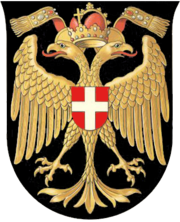
Vienna
Vienna is the capital and largest city of the Republic of Austria and one of the nine states of Austria. Vienna is Austria's primary city, with a population of about 1.723 million , and is by far the largest city in Austria, as well as its cultural, economic, and political centre...
has been long and varied, beginning when the Roman Empire
Roman Empire
The Roman Empire was the post-Republican period of the ancient Roman civilization, characterised by an autocratic form of government and large territorial holdings in Europe and around the Mediterranean....
created a military camp in the area covered by Vienna's city centre
Innere Stadt
The Innere Stadt is the 1st municipal District of Vienna . The Innere Stadt is the old town of Vienna. Until the city boundaries were expanded in 1850, the Innere Stadt was congruent with the city of Vienna...
. From that humble beginning, Vienna grew from the Roman settlement known as Vindobona to be an important trading site in the 11th century. It became the capital of the Babenberg
Babenberg
Originally from Bamberg in Franconia, now northern Bavaria, an apparent branch of the Babenbergs or Babenberger went on to rule Austria as counts of the march and dukes from 976–1248, before the rise of the house of Habsburg.-One or two families:...
dynasty and subsequently of the Austria
Austria
Austria , officially the Republic of Austria , is a landlocked country of roughly 8.4 million people in Central Europe. It is bordered by the Czech Republic and Germany to the north, Slovakia and Hungary to the east, Slovenia and Italy to the south, and Switzerland and Liechtenstein to the...
n Habsburg
Habsburg
The House of Habsburg , also found as Hapsburg, and also known as House of Austria is one of the most important royal houses of Europe and is best known for being an origin of all of the formally elected Holy Roman Emperors between 1438 and 1740, as well as rulers of the Austrian Empire and...
s, under whom it became one of Europe's
Europe
Europe is, by convention, one of the world's seven continents. Comprising the westernmost peninsula of Eurasia, Europe is generally 'divided' from Asia to its east by the watershed divides of the Ural and Caucasus Mountains, the Ural River, the Caspian and Black Seas, and the waterways connecting...
cultural hubs. During the 19th century as the capital of the Austrian Empire
Austrian Empire
The Austrian Empire was a modern era successor empire, which was centered on what is today's Austria and which officially lasted from 1804 to 1867. It was followed by the Empire of Austria-Hungary, whose proclamation was a diplomatic move that elevated Hungary's status within the Austrian Empire...
and later Austria-Hungary
Austria-Hungary
Austria-Hungary , more formally known as the Kingdoms and Lands Represented in the Imperial Council and the Lands of the Holy Hungarian Crown of Saint Stephen, was a constitutional monarchic union between the crowns of the Austrian Empire and the Kingdom of Hungary in...
, it temporarily became one of Europe's biggest cities. Since World War I
World War I
World War I , which was predominantly called the World War or the Great War from its occurrence until 1939, and the First World War or World War I thereafter, was a major war centred in Europe that began on 28 July 1914 and lasted until 11 November 1918...
, Vienna has been the capital of the Republic of Austria
Austria
Austria , officially the Republic of Austria , is a landlocked country of roughly 8.4 million people in Central Europe. It is bordered by the Czech Republic and Germany to the north, Slovakia and Hungary to the east, Slovenia and Italy to the south, and Switzerland and Liechtenstein to the...
.
Roman beginnings and early Middle Ages
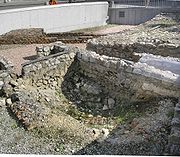
Vindobona
Vindobona was originally a Celtic settlement, and later a Roman military camp on the site of the modern city of Vienna in Austria. Around 15 BC, the kingdom of Noricum was included in the Roman Empire...
derives from a Celtic language
Celtic languages
The Celtic languages are descended from Proto-Celtic, or "Common Celtic"; a branch of the greater Indo-European language family...
, suggesting that the region must have been inhabited before Roman times. The Romans
Roman Empire
The Roman Empire was the post-Republican period of the ancient Roman civilization, characterised by an autocratic form of government and large territorial holdings in Europe and around the Mediterranean....
created a military camp (occupied by Legio X Gemina
Legio X Gemina
Legio decima Gemina , was one of the four legions used by Julius Caesar in 58 BC, for his invasion of Gaul. There are still records of the X Gemina in Vienna in the beginning of the 5th century. The legion symbol was a bull...
) during the 1st century on the site of the city centre
Innere Stadt
The Innere Stadt is the 1st municipal District of Vienna . The Innere Stadt is the old town of Vienna. Until the city boundaries were expanded in 1850, the Innere Stadt was congruent with the city of Vienna...
of present-day Vienna
Vienna
Vienna is the capital and largest city of the Republic of Austria and one of the nine states of Austria. Vienna is Austria's primary city, with a population of about 1.723 million , and is by far the largest city in Austria, as well as its cultural, economic, and political centre...
. The settlement was raised to the status of a municipium
Municipium
Municipium , the prototype of English municipality, was the Latin term for a town or city. Etymologically the municipium was a social contract between municipes, the "duty holders," or citizens of the town. The duties, or munera, were a communal obligation assumed by the municipes in exchange for...
in 212. Even today, the streets of the First District
Innere Stadt
The Innere Stadt is the 1st municipal District of Vienna . The Innere Stadt is the old town of Vienna. Until the city boundaries were expanded in 1850, the Innere Stadt was congruent with the city of Vienna...
show where the encampment placed its walls and moats. The Romans stayed until the 5th century.
Roman Vindobona was located in the outskirts of the empire and thus fell prey to the chaos of the Völkerwanderung. There are some indications that a catastrophic fire
Fire
Fire is the rapid oxidation of a material in the chemical process of combustion, releasing heat, light, and various reaction products. Slower oxidative processes like rusting or digestion are not included by this definition....
occurred around the beginning of the 5th century. However, the remains of the encampment were not deserted, and a small settlement remained. The streets and houses of early medieval Vienna followed the former Roman walls, which gives rise to the conclusion that parts of the fortification were still in place and used by the settlers. The first documented mention of the city during the Middle Ages
Middle Ages
The Middle Ages is a periodization of European history from the 5th century to the 15th century. The Middle Ages follows the fall of the Western Roman Empire in 476 and precedes the Early Modern Era. It is the middle period of a three-period division of Western history: Classic, Medieval and Modern...
dates to 881 when a battle apud Weniam was fought against the Hungarians. However, it is unclear whether this refers to the city or the River Wien. Early Vienna was centred around the Berghof.
Byzantine
Byzantine Empire
The Byzantine Empire was the Eastern Roman Empire during the periods of Late Antiquity and the Middle Ages, centred on the capital of Constantinople. Known simply as the Roman Empire or Romania to its inhabitants and neighbours, the Empire was the direct continuation of the Ancient Roman State...
copper
Copper
Copper is a chemical element with the symbol Cu and atomic number 29. It is a ductile metal with very high thermal and electrical conductivity. Pure copper is soft and malleable; an exposed surface has a reddish-orange tarnish...
coins
COinS
ContextObjects in Spans, commonly abbreviated COinS, is a method to embed bibliographic metadata in the HTML code of web pages. This allows bibliographic software to publish machine-readable bibliographic items and client reference management software to retrieve bibliographic metadata. The...
from the 6th century have been found several times in the area of today's city centre
Innere Stadt
The Innere Stadt is the 1st municipal District of Vienna . The Innere Stadt is the old town of Vienna. Until the city boundaries were expanded in 1850, the Innere Stadt was congruent with the city of Vienna...
, indicating considerable trade activity. Graves from the 6th century were found during excavations next to the Berghof, in an area around Salvatorgasse. At that time, the Lombards
Lombards
The Lombards , also referred to as Longobards, were a Germanic tribe of Scandinavian origin, who from 568 to 774 ruled a Kingdom in Italy...
controlled the area, with Slavs and Avars
Eurasian Avars
The Eurasian Avars or Ancient Avars were a highly organized nomadic confederacy of mixed origins. They were ruled by a khagan, who was surrounded by a tight-knit entourage of nomad warriors, an organization characteristic of Turko-Mongol groups...
following later. The Salzburg Annals mention a battle against the Magyars at a location called Wenia in 881, which may be a reference to Vienna. Emperor Otto I
Otto I, Holy Roman Emperor
Otto I the Great , son of Henry I the Fowler and Matilda of Ringelheim, was Duke of Saxony, King of Germany, King of Italy, and "the first of the Germans to be called the emperor of Italy" according to Arnulf of Milan...
defeated the Magyars in 955 in the Battle of Lechfeld
Battle of Lechfeld
The Battle of Lechfeld , often seen as the defining event for holding off the incursions of the Hungarians into Western Europe, was a decisive victory by Otto I the Great, King of the Germans, over the Hungarian leaders, the harka Bulcsú and the chieftains Lél and Súr...
. This allowed early Vienna to start to develop towards the Middle Ages.
Babenberg rule

Ostarrîchi
The German name of Austria, , derives from the Old High German word . A variant is recorded in the Ostarrîchi Document of 996. This word is thought to be a translation of Latin Marchia Orientalis into a local dialect. This was a march, or borderland, of the Duchy of Bavaria created in 976. Reich...
was given to the Babenberg
Babenberg
Originally from Bamberg in Franconia, now northern Bavaria, an apparent branch of the Babenbergs or Babenberger went on to rule Austria as counts of the march and dukes from 976–1248, before the rise of the house of Habsburg.-One or two families:...
family. Vienna lay at its border to Hungary
Hungary
Hungary , officially the Republic of Hungary , is a landlocked country in Central Europe. It is situated in the Carpathian Basin and is bordered by Slovakia to the north, Ukraine and Romania to the east, Serbia and Croatia to the south, Slovenia to the southwest and Austria to the west. The...
.
Vienna was an important site of trade as early as the 11th century. In the Exchange of Mautern between the Bishop of Passau
Bishop of Passau
The Diocese of Passau is a diocese of the Latin Rite of the Roman Catholic church in Germany. It is a suffragan of the Archdiocese of München und Freising. The diocese covers an area of 5,442 km². The current bishop is Wilhelm Schraml.-History:...
and Margrave Leopold IV, Vienna is mentioned as a Civitas for the first time, which indicates the existence of a well-ordered settlement.
In 1155, Duke Henry II of Austria made Vienna his capital. In 1156, Austria was raised to a duchy in the Privilegium Minus
Privilegium Minus
The Privilegium Minus is a document issued by Emperor Frederick I on September 17, 1156. It included the elevation of the Margraviate of Austria to a Duchy, which was given as an inheritable fief to the House of Babenberg. Its recipient was Frederick's paternal uncle Margrave Henry II Jasomirgott...
, with Vienna becoming the seat of the duke
Duke
A duke or duchess is a member of the nobility, historically of highest rank below the monarch, and historically controlling a duchy...
. During that time, the Schottenstift was founded.
The events surrounding the Third Crusade
Third Crusade
The Third Crusade , also known as the Kings' Crusade, was an attempt by European leaders to reconquer the Holy Land from Saladin...
, during which King Richard the Lionheart
Richard I of England
Richard I was King of England from 6 July 1189 until his death. He also ruled as Duke of Normandy, Duke of Aquitaine, Duke of Gascony, Lord of Cyprus, Count of Anjou, Count of Maine, Count of Nantes, and Overlord of Brittany at various times during the same period...
was discovered and captured by Duke Leopold V the Virtuous two days before Christmas
Christmas
Christmas or Christmas Day is an annual holiday generally celebrated on December 25 by billions of people around the world. It is a Christian feast that commemorates the birth of Jesus Christ, liturgically closing the Advent season and initiating the season of Christmastide, which lasts twelve days...
of 1192 in Erdberg near Vienna, brought an enormous ransom of 50,000 Silver Marks (about 10 to 12 tons of silver, about a third of the emperor's claims against the English. Richard had been extradited to him in March 1193). This allowed the creation of a mint
Mint (coin)
A mint is an industrial facility which manufactures coins for currency.The history of mints correlates closely with the history of coins. One difference is that the history of the mint is usually closely tied to the political situation of an era...
and the construction of city walls around the year 1200. At the U-Bahn
Vienna U-Bahn
The Vienna U-Bahn is a rapid transit system consisting of five lines. It is the backbone of one of the best performing public transport systems worldwide according to UITP in June 2009. More than 1.3 million passengers use the Vienna U-Bahn every day...
station Stubentor, some remains of the city walls can still be seen today. Because he had abused a protected crusader, Leopold V was excommunicated
Excommunication
Excommunication is a religious censure used to deprive, suspend or limit membership in a religious community. The word means putting [someone] out of communion. In some religions, excommunication includes spiritual condemnation of the member or group...
by Pope Celestine III, and died (without having been absolved) after falling from a horse in a tournament
Tournament
A tournament is a competition involving a relatively large number of competitors, all participating in a sport or game. More specifically, the term may be used in either of two overlapping senses:...
.
In 1221, Vienna received the rights of a city
City
A city is a relatively large and permanent settlement. Although there is no agreement on how a city is distinguished from a town within general English language meanings, many cities have a particular administrative, legal, or historical status based on local law.For example, in the U.S...
and as a staple port (Stapelrecht). This meant that all traders passing through Vienna had to offer their goods in the city. This allowed the Viennese to act as middlemen in trade, so that Vienna soon created a network of far-reaching trade relations, particularly along the Danube
Danube
The Danube is a river in the Central Europe and the Europe's second longest river after the Volga. It is classified as an international waterway....
basin and to Venice
Venice
Venice is a city in northern Italy which is renowned for the beauty of its setting, its architecture and its artworks. It is the capital of the Veneto region...
, and to become one of the most important cities in the Holy Roman Empire
Holy Roman Empire
The Holy Roman Empire was a realm that existed from 962 to 1806 in Central Europe.It was ruled by the Holy Roman Emperor. Its character changed during the Middle Ages and the Early Modern period, when the power of the emperor gradually weakened in favour of the princes...
.
However, it was considered embarrassing that Vienna did not have its own bishop. It is known that Duke Frederick II negotiated about the creation of a bishopric
Diocese
A diocese is the district or see under the supervision of a bishop. It is divided into parishes.An archdiocese is more significant than a diocese. An archdiocese is presided over by an archbishop whose see may have or had importance due to size or historical significance...
in Vienna, and the same is suspected of Ottokar Přemysl
Ottokar II of Bohemia
Ottokar II , called The Iron and Golden King, was the King of Bohemia from 1253 until 1278. He was the Duke of Austria , Styria , Carinthia and Carniola also....
.
Habsburg rule
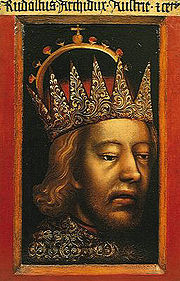
Bohemia
Bohemia is a historical region in central Europe, occupying the western two-thirds of the traditional Czech Lands. It is located in the contemporary Czech Republic with its capital in Prague...
and began to establish Habsburg
Habsburg
The House of Habsburg , also found as Hapsburg, and also known as House of Austria is one of the most important royal houses of Europe and is best known for being an origin of all of the formally elected Holy Roman Emperors between 1438 and 1740, as well as rulers of the Austrian Empire and...
rule. In Vienna, it took a relatively long time for the Habsburgs to establish their control, because partisans of Ottokar remained strong for a long time. There were several uprisings against Albert I. The family of the Paltrams vom Stephansfreithof was foremost among the insurgents.
In 1280, Jans der Enikel
Jans der Enikel
Jans der Enikel, i.e. "Jans the Grandson" was a Viennese poet and historian of the late 13th century. He wrote a Weltchronik and a Fürstenbuch , both in Middle High German verse....
wrote the "Fürstenbuch", a first history of the city.
With the Luxembourg
House of Luxembourg
The House of Luxembourg was a late medieval German dynasty, which between 1308 and 1437 ruled the Holy Roman Empire, twice interrupted by the rivaling House of Wittelsbach.-History:...
emperors, Prague
Prague
Prague is the capital and largest city of the Czech Republic. Situated in the north-west of the country on the Vltava river, the city is home to about 1.3 million people, while its metropolitan area is estimated to have a population of over 2.3 million...
became the imperial residence and Vienna stood in its shadow. The early Habsburgs attempted to extend it in order to keep up. Duke Albert II, for example, had the gothic
Gothic architecture
Gothic architecture is a style of architecture that flourished during the high and late medieval period. It evolved from Romanesque architecture and was succeeded by Renaissance architecture....
choir of the Stephansdom
Stephansdom
St. Stephen's Cathedral is the mother church of the Archdiocese of Vienna and the seat of the Archbishop of Vienna, Christoph Cardinal Schönborn, OP...
built. In 1327, Frederick the Handsome
Frederick I of Austria (Habsburg)
Frederick the Handsome or the Fair , from the House of Habsburg, was Duke of Austria and Styria from 1308 as Frederick I as well as King of Germany from 1314 as Frederick III until his death.-Biography:He was the second son of King Albert I of Germany with his wife Elisabeth of...
published his edict allowing the city to maintain an Eisenbuch (iron book) listing its privileges.
Rudolf IV of Austria deserves credit for his prudent economic policy, which raised the level of prosperity. His epithet the Founder is due to two things: first, he founded the University of Vienna
University of Vienna
The University of Vienna is a public university located in Vienna, Austria. It was founded by Duke Rudolph IV in 1365 and is the oldest university in the German-speaking world...
in 1365, and second, he began the construction of the gothic nave
Nave
In Romanesque and Gothic Christian abbey, cathedral basilica and church architecture, the nave is the central approach to the high altar, the main body of the church. "Nave" was probably suggested by the keel shape of its vaulting...
in the Stephansdom. The latter is connected to the creation of a metropolitan chapter, as a symbolic substitute for a bishop.
There was a period of inheritance disputes among the Habsburgs resulting not only in confusion, but also in an economic decline and social unrest, with disputes between the parties of patrician
Patricianship
Patricianship, the quality of belonging to a patriciate, began in the ancient world, where cities such as Ancient Rome had a class of patrician families whose members were the only people allowed to exercise many political functions...
s and artisan
Artisan
An artisan is a skilled manual worker who makes items that may be functional or strictly decorative, including furniture, clothing, jewellery, household items, and tools...
s. While the patricians supported Ernest the Iron, the artisans supported Leopold IV. In 1408, the mayor Konrad Vorlauf, an exponent of the patrician party, was executed.
After the election of Duke Albert V as German King
King of the Romans
King of the Romans was the title used by the ruler of the Holy Roman Empire following his election to the office by the princes of the Kingdom of Germany...
Albert II, Vienna became the capital of the Holy Roman Empire. Albert's name is remembered for his expulsion of the Jewish population of Vienna in 1421/22.
Eventually, in 1469, Vienna was given its own bishop, and the Stephansdom became a cathedral
Cathedral
A cathedral is a Christian church that contains the seat of a bishop...
. During the upheavals of the era of the weak Emperor Frederick III
Frederick III, Holy Roman Emperor
Frederick the Peaceful KG was Duke of Austria as Frederick V from 1424, the successor of Albert II as German King as Frederick IV from 1440, and Holy Roman Emperor as Frederick III from 1452...
, Vienna remained on the side of his opponents (first Albert VI, then Matthias Corvinus), as Frederick proved unable to maintain peace in the land vis-à-vis rampaging gangs of mercenaries (often remaining from the Hussite Wars
Hussite Wars
The Hussite Wars, also called the Bohemian Wars involved the military actions against and amongst the followers of Jan Hus in Bohemia in the period 1419 to circa 1434. The Hussite Wars were notable for the extensive use of early hand-held gunpowder weapons such as hand cannons...
).
In 1522, under Ferdinand I, Holy Roman Emperor
Ferdinand I, Holy Roman Emperor
Ferdinand I was Holy Roman Emperor from 1558 and king of Bohemia and Hungary from 1526 until his death. Before his accession, he ruled the Austrian hereditary lands of the Habsburgs in the name of his elder brother, Charles V, Holy Roman Emperor.The key events during his reign were the contest...
the Blood Judgment of Wiener Neustadt
Wiener Neustadt
-Main sights:* The Late-Romanesque Dom, consecrated in 1279 and cathedral from 1469 to 1785. The choir and transept, in Gothic style, are from the 14th century. In the late 15th century 12 statues of the Apostles were added in the apse, while the bust of Cardinal Melchior Klesl is attributed to...
led to the execution of leading members of the opposition within the city, and thus a destruction of the political structures. From then on, the city stood under direct imperial control.
In 1556, Vienna became the seat of the Emperor
Emperor
An emperor is a monarch, usually the sovereign ruler of an empire or another type of imperial realm. Empress, the female equivalent, may indicate an emperor's wife or a woman who rules in her own right...
, with Hungary
Hungary
Hungary , officially the Republic of Hungary , is a landlocked country in Central Europe. It is situated in the Carpathian Basin and is bordered by Slovakia to the north, Ukraine and Romania to the east, Serbia and Croatia to the south, Slovenia to the southwest and Austria to the west. The...
and Bohemia
Bohemia
Bohemia is a historical region in central Europe, occupying the western two-thirds of the traditional Czech Lands. It is located in the contemporary Czech Republic with its capital in Prague...
having been added to the Habsburg realm in 1526.
During this time, the city was also recatholicised after having become Protestant rather quickly. In 1551, the Jesuits were brought to town and soon gained a large influence in court. The leader of the counterreformation here was Melchior Khlesl, Bishop of Vienna from 1600.
Turkish sieges
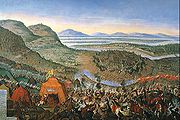
Ottoman Empire
The Ottoman EmpireIt was usually referred to as the "Ottoman Empire", the "Turkish Empire", the "Ottoman Caliphate" or more commonly "Turkey" by its contemporaries...
for the first time (the First Turkish Siege
Siege of Vienna
The Siege of Vienna in 1529 was the first attempt by the Ottoman Empire, led by Suleiman the Magnificent, to capture the city of Vienna, Austria. The siege signalled the pinnacle of the Ottoman Empire's power, the maximum extent of Ottoman expansion in central Europe, and was the result of a...
), although unsuccessfully. The city, protected by medieval walls, only barely withstood the attacks, until epidemic
Epidemic
In epidemiology, an epidemic , occurs when new cases of a certain disease, in a given human population, and during a given period, substantially exceed what is expected based on recent experience...
s and an early winter forced the Turks to retreat. The siege had shown that new fortifications were needed. Following plans by Hermes Schallauzer, Vienna was expanded to a fortress in 1548. The city was furnished with eleven bastion
Bastion
A bastion, or a bulwark, is a structure projecting outward from the main enclosure of a fortification, situated in both corners of a straight wall , facilitating active defence against assaulting troops...
s and surrounded by a moat
Moat
A moat is a deep, broad ditch, either dry or filled with water, that surrounds a castle, other building or town, historically to provide it with a preliminary line of defence. In some places moats evolved into more extensive water defences, including natural or artificial lakes, dams and sluices...
. A glacis
Glacis
A glacis in military engineering is an artificial slope of earth used in late European fortresses so constructed as to keep any potential assailant under the fire of the defenders until the last possible moment...
was created around Vienna, a broad strip without any buildings, which allowed defenders to fire freely. These fortifications, which accounted for the major part of building activities well into the 17th century, became decisive in the Second Turkish Siege
Battle of Vienna
The Battle of Vienna took place on 11 and 12 September 1683 after Vienna had been besieged by the Ottoman Empire for two months...
of 1683, as they allowed the city to maintain itself for two months, until the Turkish army
Army
An army An army An army (from Latin arma "arms, weapons" via Old French armée, "armed" (feminine), in the broadest sense, is the land-based military of a nation or state. It may also include other branches of the military such as the air force via means of aviation corps...
was defeated by the army led by the Polish
Poland
Poland , officially the Republic of Poland , is a country in Central Europe bordered by Germany to the west; the Czech Republic and Slovakia to the south; Ukraine, Belarus and Lithuania to the east; and the Baltic Sea and Kaliningrad Oblast, a Russian exclave, to the north...
King Jan Sobieski. This was the turning point in the Turkish Wars, as the Ottoman Empire was pushed back more and more during the following decades.
- See also: Ottoman wars in EuropeOttoman wars in EuropeThe wars of the Ottoman Empire in Europe are also sometimes referred to as the Ottoman Wars or as Turkish Wars, particularly in older, European texts.- Rise :...
18th century
_058.jpg)
Baroque
The Baroque is a period and the style that used exaggerated motion and clear, easily interpreted detail to produce drama, tension, exuberance, and grandeur in sculpture, painting, literature, dance, and music...
city. The most important architect
Architect
An architect is a person trained in the planning, design and oversight of the construction of buildings. To practice architecture means to offer or render services in connection with the design and construction of a building, or group of buildings and the space within the site surrounding the...
s were Johann Bernhard Fischer von Erlach
Johann Bernhard Fischer von Erlach
----Johann Bernhard Fischer von Erlach, born Johann Bernhard Fischer was probably the most influential Austrian architect of the Baroque period....
and Johann Lukas von Hildebrandt
Johann Lukas von Hildebrandt
Johann Lukas von Hildebrandt was an Italian-trained Austrian architect who designed many stately buildings and churches...
. Most construction happened in the suburbs (Vorstädte), as the nobility
Nobility
Nobility is a social class which possesses more acknowledged privileges or eminence than members of most other classes in a society, membership therein typically being hereditary. The privileges associated with nobility may constitute substantial advantages over or relative to non-nobles, or may be...
began to cover the surrounding land with garden palaces, known as Palais. The best known are the Palais Liechtenstein
Stadtpalais Liechtenstein
Stadtpalais Liechtenstein , a residential building at Bank Gasse 9, in the I. district of Vienna's Innere Stadt, is one of two palaces in Vienna belonging to the Princely Family of Liechtenstein...
, Palais Modena
Palais Modena
Palais Modena is a palace in Vienna, Austria. It was built and owned by the Habsburgs of the Modenese branch of the family.Today it houses offices of the Federal Ministry for the Interior.-External links:...
, Schönbrunn Palace
Schönbrunn Palace
Schönbrunn Palace is a former imperial 1,441-room Rococo summer residence in Vienna, Austria. One of the most important cultural monuments in the country, since the 1960s it has been one of the major tourist attractions in Vienna...
, Palais Schwarzenberg
Palais Schwarzenberg
Palais Schwarzenberg is a Baroque palace in front of Schwarzenbergplatz, Landstraße, the 3rd district of Vienna, Austria. It is owned by the princely Schwarzenberg family....
, and the Belvedere
Belvedere (palace)
The Belvedere is a historical building complex in Vienna, Austria, consisting of two Baroque palaces the Upper and Lower Belvedere, the Orangery, and the Palace Stables. The buildings are set in a Baroque park landscape in the 3rd district of the city, south-east of its centre. It houses the...
(the garden palais of Prince Eugene of Savoy
Prince Eugene of Savoy
Prince Eugene of Savoy , was one of the most successful military commanders in modern European history, rising to the highest offices of state at the Imperial court in Vienna. Born in Paris to aristocratic Italian parents, Eugene grew up around the French court of King Louis XIV...
). In 1704, an outer fortification, the Linienwall, was built around the Vorstädte.
After the extensive plague
Bubonic plague
Plague is a deadly infectious disease that is caused by the enterobacteria Yersinia pestis, named after the French-Swiss bacteriologist Alexandre Yersin. Primarily carried by rodents and spread to humans via fleas, the disease is notorious throughout history, due to the unrivaled scale of death...
epidemics
Pandemic
A pandemic is an epidemic of infectious disease that is spreading through human populations across a large region; for instance multiple continents, or even worldwide. A widespread endemic disease that is stable in terms of how many people are getting sick from it is not a pandemic...
of 1679 and 1713
Great Plague of Vienna
The Great Plague of Vienna occurred in 1679 in Vienna, Austria, the imperial residence of the Austrian Habsburg rulers. From contemporary descriptions, the disease is believed to have been bubonic plague, which is caused by the bacterium Yersinia pestis, carried by fleas associated with the black...
, the population began to grow steadily. It is estimated that 150,000 people lived in Vienna in 1724, and 200,000 in 1790. At that time, the first factories were built, starting in Leopoldstadt
Leopoldstadt
Leopoldstadt is the 2nd municipal District of Vienna . There are inhabitants over . It is situated in the heart of the city and, together with Brigittenau , forms a large island surrounded by the Danube Canal and, to the north, the Danube. It is named after Leopold I, Holy Roman Emperor...
. Leopoldstadt also became a site where many Jews lived, as they had been driven out of their 50-year old ghetto
Ghetto
A ghetto is a section of a city predominantly occupied by a group who live there, especially because of social, economic, or legal issues.The term was originally used in Venice to describe the area where Jews were compelled to live. The term now refers to an overcrowded urban area often associated...
in 1670.
Hygienic
Hygiene
Hygiene refers to the set of practices perceived by a community to be associated with the preservation of health and healthy living. While in modern medical sciences there is a set of standards of hygiene recommended for different situations, what is considered hygienic or not can vary between...
problems began to become noticeable: sewers and street cleaning began to develop. Also in this time, the first house numbers (the Konskriptionsnummern) were issued, and the government postal
Mail
Mail, or post, is a system for transporting letters and other tangible objects: written documents, typically enclosed in envelopes, and also small packages are delivered to destinations around the world. Anything sent through the postal system is called mail or post.In principle, a postal service...
system began to develop.
Under Emperor Joseph II
Joseph II, Holy Roman Emperor
Joseph II was Holy Roman Emperor from 1765 to 1790 and ruler of the Habsburg lands from 1780 to 1790. He was the eldest son of Empress Maria Theresa and her husband, Francis I...
, the city administration was modernized in 1783: officials in charge of only the city were introduced, and the Magistrate
Magistrate
A magistrate is an officer of the state; in modern usage the term usually refers to a judge or prosecutor. This was not always the case; in ancient Rome, a magistratus was one of the highest government officers and possessed both judicial and executive powers. Today, in common law systems, a...
was created. At the same time, the graveyard
Graveyard
A graveyard is any place set aside for long-term burial of the dead, with or without monuments such as headstones...
s within the city were closed.
19th century
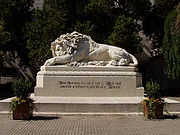
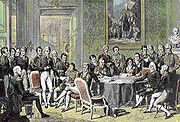
Napoleonic Wars
The Napoleonic Wars were a series of wars declared against Napoleon's French Empire by opposing coalitions that ran from 1803 to 1815. As a continuation of the wars sparked by the French Revolution of 1789, they revolutionised European armies and played out on an unprecedented scale, mainly due to...
, Vienna was taken by Napoleon twice, in 1805 and 1809. The first conquest happened without a battle. Three French
France
The French Republic , The French Republic , The French Republic , (commonly known as France , is a unitary semi-presidential republic in Western Europe with several overseas territories and islands located on other continents and in the Indian, Pacific, and Atlantic oceans. Metropolitan France...
marshal
Marshal
Marshal , is a word used in several official titles of various branches of society. The word is an ancient loan word from Old French, cf...
s crossed the Taborbrücke (Tábor
Tábor
Tábor is a city of the Czech Republic, in the South Bohemian Region. It is named after Mount Tabor, which is believed by many to be the place of the Transfiguration of Christ; however, the name became popular and nowadays translates to "camp" or "encampment" in the Czech language.The town was...
Bridge), the only Danube bridge at that time (which of course was strongly defended), and convinced the Austrian commander that the war was already over. In the meantime, the French army could easily enter the city and was greeted by the population, rather with interest than with rejection. Napoleon allowed 10,000 men of the Vienna national guard to remain armed and left the arsenal to them when he left, as complete as he had found it. However, the second occupation happened only after heavy fire. Shortly after that, Napoleon suffered his first large defeat at Aspern, nearby.
After Napoleon's final defeat, the Congress of Vienna
Congress of Vienna
The Congress of Vienna was a conference of ambassadors of European states chaired by Klemens Wenzel von Metternich, and held in Vienna from September, 1814 to June, 1815. The objective of the Congress was to settle the many issues arising from the French Revolutionary Wars, the Napoleonic Wars,...
took place from September 18, 1814 to June 9, 1815, in which the political map of Europe
Europe
Europe is, by convention, one of the world's seven continents. Comprising the westernmost peninsula of Eurasia, Europe is generally 'divided' from Asia to its east by the watershed divides of the Ural and Caucasus Mountains, the Ural River, the Caspian and Black Seas, and the waterways connecting...
was redrawn. The congress members indulged in many social events, which induced the witty Charles Joseph, Prince de Ligne
Charles Joseph, Prince de Ligne
Charles-Joseph Lamoral, 7th Prince de Ligne in French, Charles Joseph Lamoral 7te Fürst von Ligne : was a Field marshal and writer, and member of the princely family of Ligne.-Military service:He was the son of Field Marshal Claude Lamoral, 6th Prince of Ligne and Elisabeth Alexandrine...
to famously say: Le congres danse beaucoup, mais il ne marche pas ("The congress dances, but does not progress"). The events cost Austria
Austrian Empire
The Austrian Empire was a modern era successor empire, which was centered on what is today's Austria and which officially lasted from 1804 to 1867. It was followed by the Empire of Austria-Hungary, whose proclamation was a diplomatic move that elevated Hungary's status within the Austrian Empire...
a great deal of money, which was reflected in mockery about the major participants:
- Alexander of RussiaAlexander I of RussiaAlexander I of Russia , served as Emperor of Russia from 23 March 1801 to 1 December 1825 and the first Russian King of Poland from 1815 to 1825. He was also the first Russian Grand Duke of Finland and Lithuania....
: loves for all - Frederick William of PrussiaFrederick William III of PrussiaFrederick William III was king of Prussia from 1797 to 1840. He was in personal union the sovereign prince of the Principality of Neuchâtel .-Early life:...
: thinks for all - Frederick of DenmarkFrederick VI of DenmarkFrederick VI reigned as King of Denmark , and as king of Norway .-Regent of Denmark:Frederick's parents were King Christian VII and Caroline Matilda of Wales...
: speaks for all - Maximilian of Bavaria: drinks for all
- Frederick of WürttembergFrederick I of WürttembergFrederick I William Charles of Württemberg was the first King of Württemberg. He was known for his size: at and about , he was in contrast to Napoleon, who recognized him as King of Württemberg.-Biography:...
: eats for all - Emperor Francis of AustriaFrancis II, Holy Roman EmperorFrancis II was the last Holy Roman Emperor, ruling from 1792 until 6 August 1806, when he dissolved the Empire after the disastrous defeat of the Third Coalition by Napoleon at the Battle of Austerlitz...
: pays for all
The first half of the century was characterised by intensive industrialization, with Vienna being attached to the railway network in 1837.
The French February Revolution of 1848 had an effect as far away as Vienna: on March 13, the March Revolution, which forced long-serving chancellor Metternich
Klemens Wenzel von Metternich
Prince Klemens Wenzel von Metternich was a German-born Austrian politician and statesman and was one of the most important diplomats of his era...
to resign.
Expansion under Emperor Franz Joseph I
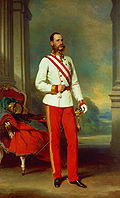
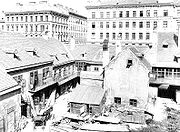


Innere Stadt
The Innere Stadt is the 1st municipal District of Vienna . The Innere Stadt is the old town of Vienna. Until the city boundaries were expanded in 1850, the Innere Stadt was congruent with the city of Vienna...
. In 1858, the fortifications were demolished, and the broad Ringstraße
Ringstraße
The Ringstraße is a circular road surrounding the Innere Stadt district of Vienna, Austria and is one of its main sights...
boulevard was built in their place. Many monumental buildings were built alongside it. The Ringstraße Style (Historicism
Historicism (art)
Historicism refers to artistic styles that draw their inspiration from copying historic styles or artisans. After neo-classicism, which could itself be considered a historicist movement, the 19th century saw a new historicist phase marked by a return to a more ancient classicism, in particular in...
) characterises the architecture of Vienna to this day. The period peaked in the World Exhibition of 1873, immediately before the stock market crash
Stock market crash
A stock market crash is a sudden dramatic decline of stock prices across a significant cross-section of a stock market, resulting in a significant loss of paper wealth. Crashes are driven by panic as much as by underlying economic factors...
, which ended the Gründerzeit
Gründerzeit
' refers to the economic phase in 19th century Germany and Austria before the great stock market crash of 1873. At this time in Central Europe the age of industrialisation was taking place, whose beginnings were found in the 1840s...
("foundation era").
In 1861, the Liberals won the first (relatively) free elections after the end of neoabsolutism.
After the great flood of 1830, Regulation of the Danube was frequently considered. It was finally put into practice during the 1860s. The many branches of the Danube
Danube
The Danube is a river in the Central Europe and the Europe's second longest river after the Volga. It is classified as an international waterway....
were removed, and a straight course was created away from the city centre. The branch near the central city was made narrower and has been known under the somewhat misleading name Donaukanal
Donaukanal
The Donaukanal is a former arm of the river Danube, now regulated as a water channel , within the city of Vienna, Austria...
(Danube Canal) ever since.
During that period, the population of Vienna increased sharply, mostly because of immigration. Censuses were conducted regularly from 1869 onwards, which showed an all-time high of population in 1910, with 2,031,000 inhabitants.
Around 1900, Vienna became a centre of the Jugendstil (Art Nouveau
Art Nouveau
Art Nouveau is an international philosophy and style of art, architecture and applied art—especially the decorative arts—that were most popular during 1890–1910. The name "Art Nouveau" is French for "new art"...
), most of all with Otto Wagner
Otto Wagner
Otto Koloman Wagner was an Austrian architect and urban planner, known for his lasting impact on the appearance of his home town Vienna, to which he contributed many landmarks.-Life:...
and the association of artists known as Vienna Secession
Vienna Secession
The Vienna Secession was formed in 1897 by a group of Austrian artists who had resigned from the Association of Austrian Artists, housed in the Vienna Künstlerhaus. This movement included painters, sculptors, and architects...
(after which the characteristic building on Karlsplatz
Karlsplatz
Karlsplatz is a town square on the border of the first and fourth districts of Vienna. It is one of the most frequented and best connected transportation hubs in Vienna. The Karlskirche is located here....
is named).
In 1890, the city was expanded for a second time: the (Vororte) suburbs beyond the old Linienwall were incorporated into the town as the districts 11 to 19 (the 10th district
Favoriten
Favoriten, the 10th district of Vienna, Austria , is located south of the central districts. It is south of Innere Stadt, Wieden and Margareten...
had been created in 1874 by the division of the fourth
Wieden
Wieden is the 4th municipal District of Vienna, Austria . It is near the center of Vienna and was established as a district in 1850, but borders changed later...
). Leopoldstadt
Leopoldstadt
Leopoldstadt is the 2nd municipal District of Vienna . There are inhabitants over . It is situated in the heart of the city and, together with Brigittenau , forms a large island surrounded by the Danube Canal and, to the north, the Danube. It is named after Leopold I, Holy Roman Emperor...
was divided in 1900, with the northern part becoming the 20th district (Brigittenau
Brigittenau
Brigittenau is the 20th District of Vienna . It is located north of the central districts, north of Leopoldstadt on the same island area between the Danube and the Danube Canal...
). In 1904, Floridsdorf
Floridsdorf
Floridsdorf is the 21st district of Vienna, Austria .Floridsdorf is located in the northern part of Vienna.The District Office and the centre of Floridsdorf are located round Am Spitz, at the junction of Prager Straße and Brünner Straße .Since 2004, Floridsdorf has had its own tower: the...
became part of Vienna as 21st district.
During those years, Karl Lueger
Karl Lueger
Karl Lueger was an Austrian politician and mayor of Vienna. The populist and anti-Semitic politics of his Christian Social Party are sometimes viewed as a model for Hitler's Nazism.- Career :...
was the leading figure of city politics. Neither his dedication to social policy
Social policy
Social policy primarily refers to guidelines, principles, legislation and activities that affect the living conditions conducive to human welfare. Thus, social policy is that part of public policy that has to do with social issues...
can be denied, nor other works for the municipality (such as the Wiener Hochquellwasserleitung, bringing fresh water from the mountains to Vienna and the creation of a belt of meadows and forests around the city). However, these positive aspects were coupled with his raving and rhetorically well presented anti-Semitism
Anti-Semitism
Antisemitism is suspicion of, hatred toward, or discrimination against Jews for reasons connected to their Jewish heritage. According to a 2005 U.S...
, which enjoyed popular support.
World War I and the First Republic
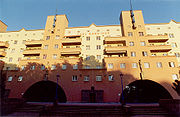
World War I
World War I , which was predominantly called the World War or the Great War from its occurrence until 1939, and the First World War or World War I thereafter, was a major war centred in Europe that began on 28 July 1914 and lasted until 11 November 1918...
(1914-1918) did not result in an immediate threat to Vienna, but it led to a lack of supplies because of the economic embargo imposed by the Entente
Triple Entente
The Triple Entente was the name given to the alliance among Britain, France and Russia after the signing of the Anglo-Russian Entente in 1907....
powers, which resulted in a shortage of food
Food
Food is any substance consumed to provide nutritional support for the body. It is usually of plant or animal origin, and contains essential nutrients, such as carbohydrates, fats, proteins, vitamins, or minerals...
and clothes. The skyrocketing costs of the war, mostly financed by borrowing, resulted in tremendous inflation that - as in Germany - wiped out the savings of many middle-class Viennese. One interesting quirk is that the 1916 Rent Control
Rent control
Rent control refers to laws or ordinances that set price controls on the renting of residential housing. It functions as a price ceiling.Rent control exists in approximately 40 countries around the world...
was never officially repealed; even today there are buildings where the 1916 rent - by now essentially meaningless - applies.
The end of the war was also the end of Austria-Hungary
Austria-Hungary
Austria-Hungary , more formally known as the Kingdoms and Lands Represented in the Imperial Council and the Lands of the Holy Hungarian Crown of Saint Stephen, was a constitutional monarchic union between the crowns of the Austrian Empire and the Kingdom of Hungary in...
. On November 12, 1918, the Republic of Deutsch-Österreich, or German-Austria, was proclaimed in front of the parliament
Parliament of Austria
In the Parliament of Austria is vested the legislative power of the Republic of Austria. The institution consists of two chambers,* the National Council and* the Federal Council ....
. The population was concentrated in the capital, which was often called a hydrocephalus
Hydrocephalus
Hydrocephalus , also known as "water in the brain," is a medical condition in which there is an abnormal accumulation of cerebrospinal fluid in the ventricles, or cavities, of the brain. This may cause increased intracranial pressure inside the skull and progressive enlargement of the head,...
because of this.
In 1921, Vienna was separated from the surrounding Lower Austria
Lower Austria
Lower Austria is the northeasternmost state of the nine states in Austria. The capital of Lower Austria since 1986 is Sankt Pölten, the most recently designated capital town in Austria. The capital of Lower Austria had formerly been Vienna, even though Vienna is not officially part of Lower Austria...
and became a state
States of Austria
Austria is a federal republic made up of nine states, known in German as Länder . Since Land is also the German word for a country, the term Bundesländer is often used instead to avoid ambiguity. The Constitution of Austria uses both terms...
of its own. The left-wing Social Democrats
SPO
- Technology :SPO: Microsoft SharePoint Online, Microsoft Cloud Computing, Office 365. See Microsoft Online Services-Economics:* Secondary Public Offering, an equity capital market instrument...
, who had dominated since the end of the war, were now in charge of the city administration. "Red Vienna
Red Vienna
Red Vienna was the nickname of the capital of Austria between 1918 and 1934, when the Social Democrats had the majority and the city was democratically governed for the first time.-Social situation after World War I:...
" was considered an international model. Many notable Gemeindebau
Gemeindebau
Gemeindebau is a German word for "municipality building". It refers to residential buildings erected by a municipality, usually to provide low-cost public housing....
ten (low-cost residential estates) were built during that period.
However, the increasing economic difficulties resulted in a political radicalization and polarisation of the political parties. On the social democratic side, the left-wing Republikanische Schutzbund (Republican Protective Alliance) was formed in 1923/24, which was a well-organised and well-equipped paramilitary group. It was opposed by the right-wing Heimwehr
Heimwehr
The Heimwehr or sometimes Heimatschutz were a Nationalist, initially paramilitary group operating within Austria during the 1920s and 1930s; they were similar in methods, organisation, and ideology to Germany's Freikorps...
("Home Guard"), which had been formed after the end of the war from local guards and similar combat units.
Austrofascism
.jpg)
Palace of Justice (Vienna)
The Palace of Justice is a building located in the Austrian captal, Vienna. It is located in Schmerlingplatz, a square of the central district of Innere Stadt.-History:...
) in 1927 after violent demonstrations, the collapse of the Creditanstalt
Creditanstalt
The Creditanstalt was an Austrian bank. The Creditanstalt was based in Vienna, founded in 1855 as K. k. priv. Österreichische Credit-Anstalt für Handel und Gewerbe by the Rothschild family...
, the largest bank
Bank
A bank is a financial institution that serves as a financial intermediary. The term "bank" may refer to one of several related types of entities:...
of the country, and finally the dissolution of parliament in 1933, marked the way to the Civil War
Austrian Civil War
The Austrian Civil War , also known as the February Uprising , is a term sometimes used for a few days of skirmishes between socialist and conservative-fascist forces between 12 February and 16 February 1934, in Austria...
in February of 1934. After Engelbert Dollfuß, who had been Chancellor of Austria
Chancellor of Austria
The Federal Chancellor is the head of government in Austria. Its deputy is the Vice-Chancellor. Before 1918, the equivalent office was the Minister-President of Austria. The Federal Chancellor is considered to be the most powerful political position in Austrian politics.-Appointment:The...
and foreign minister since 1932, had forbidden the Nazi Party, the Communist Party
KPO
Meanings of KPO:* Knowledge process outsourcing.* KPÖ , Communist Party of Austria.* Kommunistische Partei Deutschlands , Communist Party Opposition....
and the Schutzbund
Republikanischer Schutzbund
The Republikanischer Schutzbund was a paramilitary organization established in 1923 by the Sozialdemokratische Arbeiterpartei Österreichs to secure power in the face of rising political radicalization after World War I....
in 1933, he extended the ban to the Social Democratic Party in 1934 after the February Uprising. The only legal political organization was the new movement of his own creation, the Vaterländische Front. Dollfuß created an authoritarian regime called Ständestaat and ruled without parliamentary approval (also see Austrofascism
Austrofascism
Austrofascism is a term which is frequently used by historians to describe the authoritarian rule installed in Austria with the May Constitution of 1934, which ceased with the forcible incorporation of the newly-founded Federal State of Austria into Nazi Germany in 1938...
).
Third Reich
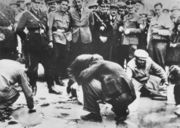
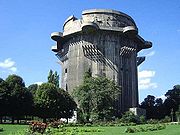
Nazi Germany
Nazi Germany , also known as the Third Reich , but officially called German Reich from 1933 to 1943 and Greater German Reich from 26 June 1943 onward, is the name commonly used to refer to the state of Germany from 1933 to 1945, when it was a totalitarian dictatorship ruled by...
occupied and annexed Austria in a process known as the Anschluss
Anschluss
The Anschluss , also known as the ', was the occupation and annexation of Austria into Nazi Germany in 1938....
. Adolf Hitler
Adolf Hitler
Adolf Hitler was an Austrian-born German politician and the leader of the National Socialist German Workers Party , commonly referred to as the Nazi Party). He was Chancellor of Germany from 1933 to 1945, and head of state from 1934 to 1945...
was rapturously received in Vienna by large crowds of admirers and famously gave a speech at Heldenplatz
Heldenplatz
The Heldenplatz is a historical plaza in Vienna. Many important actions took place here, most notably Adolf Hitler's announcement of the Anschluss of Austria to the German Reich in 1938.-The Plaza:...
in which he welcomed his homeland into the Reich
Reich
Reich is a German word cognate with the English rich, but also used to designate an empire, realm, or nation. The qualitative connotation from the German is " sovereign state." It is the word traditionally used for a variety of sovereign entities, including Germany in many periods of its history...
. Hitler's anti-Jewish policies fell on fertile soil in Vienna, where latent anti-Semitism
Anti-Semitism
Antisemitism is suspicion of, hatred toward, or discrimination against Jews for reasons connected to their Jewish heritage. According to a 2005 U.S...
had increased during the early 20th century. Immediately after the Anschluss the Jews of Vienna were subject to violence from the State as well as from Antisemites acting out of their own sadism. During the Reichskristallnacht on November 9, 1938, the synagogue
Synagogue
A synagogue is a Jewish house of prayer. This use of the Greek term synagogue originates in the Septuagint where it sometimes translates the Hebrew word for assembly, kahal...
s, the Jewish centres of not only religious, but also social life, were destroyed. In August, the KZ Oberlanzendorf Wien (Central Office for Jewish Emigration
Central Office for Jewish Emigration
The Central Office for Jewish Emigration was a designation of Nazi institutions in Vienna, Prague and Amsterdam. Its purpose was to expel Jews from Nazi-controlled areas.- History :...
) was created. Its head was Adolf Eichmann
Adolf Eichmann
Adolf Otto Eichmann was a German Nazi and SS-Obersturmbannführer and one of the major organizers of the Holocaust...
. On the whole, and despite some instances of anti-Semitism, the city of Vienna was less supportive of the Nazi regime than was the rest of Austria. This however did not reach any extent of an organised resistance. Hitler himself hated Vienna and was determined to build up Linz
Linz
Linz is the third-largest city of Austria and capital of the state of Upper Austria . It is located in the north centre of Austria, approximately south of the Czech border, on both sides of the river Danube. The population of the city is , and that of the Greater Linz conurbation is about...
, his childhood hometown, and relegate Vienna to backwater status.
In the course of the expansion of the city in 1938, 91 adjoining municipalities were incorporated into the city, from which the 22nd (Groß-Enzersdorf
Groß-Enzersdorf
Groß-Enzersdorf is a town and municipality in the district of Gänserndorf in the Austrian state of Lower Austria, directly to the east of Vienna and north of the river Danube...
), the 23rd (Schwechat
Schwechat
Schwechat is a city south-east of Vienna known for the Vienna International Airport and Schwechater beer. It is also home to the refineries belonging to the Austrian national oil company OMV.- Geography :...
), the 24th (Mödling
Mödling
Mödling is the capital of the Austrian district of the same name located approximately 14 km south of Vienna.The settlement dates back to the Neolithic. In medieval times, the town was the residence of a branch of the Babenberger family, as a result of which it received the nickname...
), the 25th (Liesing
Liesing
Liesing is the 23rd district of Vienna . It is on the southwest edge of Vienna, Austria.It was formed after Austria's Anschluss with Germany, when Vienna expanded from 21 districts to 26...
) and the 26th (Klosterneuburg
Klosterneuburg
Klosterneuburg is an attractive small town in Lower Austria, Austria with a population of 24,442.It is located on the Danube, immediately north of Vienna, from which it is separated by the Kahlenberg and Leopoldsberg hills...
) districts were created. With an area of 1,224 km², this made Vienna the city with the largest territory in the Third Reich. During the war, the city housed 12 sub-camps of the infamous Mauthausen-Gusen concentration camp
Mauthausen-Gusen concentration camp
Mauthausen Concentration Camp grew to become a large group of Nazi concentration camps that was built around the villages of Mauthausen and Gusen in Upper Austria, roughly east of the city of Linz.Initially a single camp at Mauthausen, it expanded over time and by the summer of 1940, the...
, located in various parts of the city.
Although originally out of range of Allied bombers operating from England, by 1943 the city began being attacked by bombers based in Italy. Large flak tower
Flak tower
Flak towers were 8 complexes of large, above-ground, anti-aircraft gun blockhouse towers constructed in the cities of Berlin , Hamburg , and Vienna from 1940 onwards....
s were constructed in the city as defensive structures against these bombers. These structures remain in place today, as they are so thick and their roots so deep that to destroy them would damage surrounding buildings. The bombings of 1944 and 1945 and the vicious fighting during the subsequent conquest of Vienna by Soviet
Soviet Union
The Soviet Union , officially the Union of Soviet Socialist Republics , was a constitutionally socialist state that existed in Eurasia between 1922 and 1991....
troops in April 1945 caused much destruction within the city. Luckily some historic buildings survived the bombardment; many more were painstakingly reconstructed after the war.
Allied occupation
Only a few days after the war, a provisional city government and administration was created. Also, the political parties were recreated. On April 29, 1945 the parliament building passed from the occupation force to the new Austrian government, and Karl RennerKarl Renner
Karl Renner was an Austrian politician. He was born in Untertannowitz in the Austro-Hungarian Empire and died in Vienna...
announced the reinstitution of the democratic Republic of Austria. Vienna was divided into five occupation zones between the Soviet Union
Soviet Union
The Soviet Union , officially the Union of Soviet Socialist Republics , was a constitutionally socialist state that existed in Eurasia between 1922 and 1991....
, the USA, the UK
United Kingdom
The United Kingdom of Great Britain and Northern IrelandIn the United Kingdom and Dependencies, other languages have been officially recognised as legitimate autochthonous languages under the European Charter for Regional or Minority Languages...
, the France
France
The French Republic , The French Republic , The French Republic , (commonly known as France , is a unitary semi-presidential republic in Western Europe with several overseas territories and islands located on other continents and in the Indian, Pacific, and Atlantic oceans. Metropolitan France...
, and with the first district (city centre) being patrolled by all four.
The first municipal elections were held in November 1945.
Of the 100 seats in the municipal council, the left-wing Social Democratic Party
Social Democratic Party of Austria
The Social Democratic Party of Austria is one of the oldest political parties in Austria. The SPÖ is one of the two major parties in Austria, and has ties to trade unions and the Austrian Chamber of Labour. The SPÖ is among the few mainstream European social-democratic parties that have preserved...
captured 58, the right-wing Austrian Peoples Party
OVP
OVP is a three-letter abbreviation that may refer to:*The Office of the Vice President of the United States*The Office of the Vice President of the Philippines*OVP , a light sub-machine gun developed in Italy...
36, and the Communists
Communist Party of Austria
The Communist Party of Austria is a communist party based in Austria. Established in 1918, it was banned between 1933 and 1945 under both the Austrofascist regime, and German control of Austria during World War II...
6. In 1946, it was decided that the expansion of city territory of 1938 should be reverted, but this law was delayed by a veto of the occupying powers and was not put into practice until 1954. Two districts remained with Vienna, namely the 22nd one (Donaustadt
Donaustadt
Donaustadt is the 22nd district of Vienna, Austria .Donaustadt is the eastern fourth of Vienna.- Geography :The Donaustadt district is in the northeast part of Vienna and is the largest of the districts in area, occupying about one-quarter of the Vienna city area, 102.24 km².It borders the...
) north of the Danube and the 23rd one (Liesing
Liesing
Liesing is the 23rd district of Vienna . It is on the southwest edge of Vienna, Austria.It was formed after Austria's Anschluss with Germany, when Vienna expanded from 21 districts to 26...
) in the south (some other districts gained some Lower Austria
Lower Austria
Lower Austria is the northeasternmost state of the nine states in Austria. The capital of Lower Austria since 1986 is Sankt Pölten, the most recently designated capital town in Austria. The capital of Lower Austria had formerly been Vienna, even though Vienna is not officially part of Lower Austria...
n territory).
Modern history since 1955
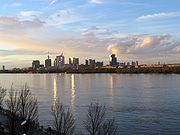
Austrian State Treaty
The Austrian State Treaty or Austrian Independence Treaty re-established Austria as a sovereign state. It was signed on May 15, 1955, in Vienna at the Schloss Belvedere among the Allied occupying powers and the Austrian government...
". The Austrian Parliament immediately amended the treaty to establish Austria's future neutrality and non-alignment (similar to that of Switzerland). This peace treaty was called a state treaty because Austria had temporarily ceased to exist in 1938.
After the war, as everywhere in Western Europe
Western Europe
Western Europe is a loose term for the collection of countries in the western most region of the European continents, though this definition is context-dependent and carries cultural and political connotations. One definition describes Western Europe as a geographic entity—the region lying in the...
, there was an enormous economic boom, among other things because of the economic aid resulting from the Marshall Plan
Marshall Plan
The Marshall Plan was the large-scale American program to aid Europe where the United States gave monetary support to help rebuild European economies after the end of World War II in order to combat the spread of Soviet communism. The plan was in operation for four years beginning in April 1948...
.
Public transport in Vienna was improved by the introduction of the new U-Bahn
Vienna U-Bahn
The Vienna U-Bahn is a rapid transit system consisting of five lines. It is the backbone of one of the best performing public transport systems worldwide according to UITP in June 2009. More than 1.3 million passengers use the Vienna U-Bahn every day...
network, the first part of which was opened in 1978. During the 1970s, Vienna became the third official seat of the United Nations
United Nations
The United Nations is an international organization whose stated aims are facilitating cooperation in international law, international security, economic development, social progress, human rights, and achievement of world peace...
, and the UNO-City was built. At the end of the 20th century, a skyline
Skyline
A skyline is the overall or partial view of a city's tall buildings and structures consisting of many skyscrapers in front of the sky in the background. It can also be described as the artificial horizon that a city's overall structure creates. Skylines serve as a kind of fingerprint of a city, as...
consisting of several skyscrapers was created with, among others, the Andromeda Tower and Millennium Tower
Millennium Tower, Vienna
The Millennium Tower, located at Handelskai 94-96 in the 20th district of Brigittenau in Vienna, is the tallest building and 3rd tallest structure in Austria at 171 metres after the Donauturm. An antenna mounted on top of the tower brings the architectural height to 202 metres but does not count...
on the left and right side of the Danube. Furthermore, a complex of skyscrapers was planned at the site of the Wien Mitte railway station, which might have endangered the position of Vienna's centre as a UNESCO World Heritage Site
World Heritage Site
A UNESCO World Heritage Site is a place that is listed by the UNESCO as of special cultural or physical significance...
. The project has since been redesigned.
Vienna was the capital of the surrounding Bundesland
States of Austria
Austria is a federal republic made up of nine states, known in German as Länder . Since Land is also the German word for a country, the term Bundesländer is often used instead to avoid ambiguity. The Constitution of Austria uses both terms...
of Lower Austria until 1986, when it was replaced by Sankt Pölten
Sankt Pölten
Sankt Pölten is the capital city of the State of Lower Austria in northeast Austria. With inhabitants , it is Lower Austria's largest city...
. As Vienna was not a geographical part of Lower Austria it was a capital outside of the territory it served.
In the municipal elections of 2001, the Social Democrats regained an absolute majority
Majority
A majority is a subset of a group consisting of more than half of its members. This can be compared to a plurality, which is a subset larger than any other subset; i.e. a plurality is not necessarily a majority as the largest subset may consist of less than half the group's population...
. With the Liberal Forum
Liberal Forum
The Liberal Forum is a small classical liberal party in Austria. The party is currently led by Angelika Mlinar, and is a member of the Liberal International and the European Liberal Democrat and Reform Party.-Founding:...
, not gaining enough votes, only four parties have been represented in the municipal council since then. In the 2005 elections, the Social Democrats further increased their majority.

